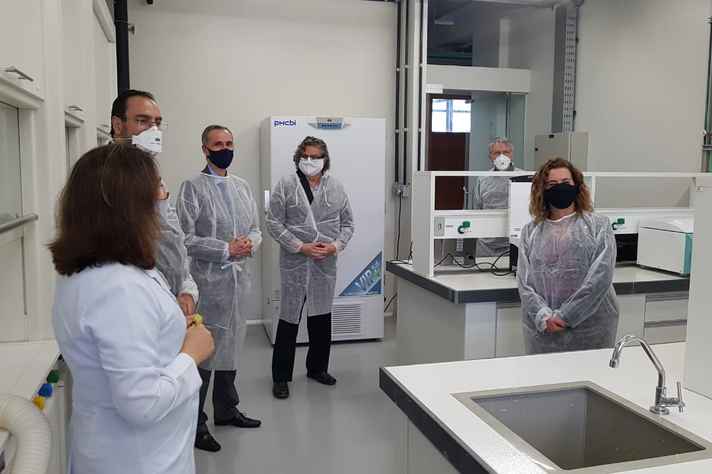UFMG structures reference center for material analysis of the Brumadinho dam
Judge of TJMG visited the laboratory complex that was installed in the Department of Chemistry at UFMG with resources from judicial guarantees
Posted on 09/12/2020
Rector Sandra Regina Goulart Almeida and Judge Elton Pupo Nogueira, from the Court of Justice of Minas Gerais (TJMG), visited, this Monday, the 7th, the facilities of the Reference Center for Environmental Innovation (CRA), located in the Annex 3 from the Chemistry Department. A component of the Brumadinho UFMG Project, this laboratory complex will host analyzes of materials related to the rupture of Vale's Mina Córrego do Feijão dam, which took place in January 2019 in the city of the Metropolitan Region of Belo Horizonte.

On his visit, Judge Elton Pupo - representative of the judiciary at the head of civil proceedings related to the dam breach - highlighted the importance of having an institution like UFMG in the state, “with know-how for highly complex research”. "It is an institution capable of delivering to the mining society what we need, which is cutting-edge scientific knowledge and research," he said. The analyzes carried out by the laboratory will contribute to a more accurate assessment of the extent of socioeconomic, environmental, health, education and urban structures impacts, among others, caused by the disaster.
“It is clear that [hosting the reference center] will also have a very big impact for us, as an institution”, said the dean Sandra Goulart Almeida, highlighting the multipurpose vocation of the space, which in the future will also be used for teaching, forming future staff professional and scientific staff. "But our first priority will be to meet this very important demand from the government," he said. According to the dean, the laboratory will dedicate itself exclusively, at least in its first 12 months, to the analysis of the contamination indexes of samples related to the rupture of the dam. After this work is completed, the results will be forwarded to the TJMG.
“This union between government institutions is the way to a better country and to a more equitable society”, added Sandra, accompanied by other representatives of the Central Administration, such as vice-chancellor Alessandro Fernandes Moreira, and the president of Fundep, Alfredo Gontijo de Oliveira, responsible for the financial management of the project. “This is a job that the University has to develop as a public institution and as a patrimony of the state of Minas Gerais. It is part of UFMG's mission, ”she said. "Disasters like this can no longer happen," said the dean.
Impact identification and assessment
The Brumadinho UFMG Project was launched with the objective of assisting in the identification and evaluation of the impacts resulting from the rupture of Vale's Mina Córrego do Feijão dam in January 2019. Studies and research carried out in its scope do not serve the parties, but the company itself Court of the 2nd Public Finance Court of the District of Belo Horizonte, which is at the head of the lawsuit filed against Vale.
The project is the result of the transfer to UFMG, by the TJMG, of resources from judicial guarantees within the scope of the process to which the mining company responds. Judge Elton Pupo Nogueira's visit to the laboratory thus represents the University's accountability to the Court of Justice.
The Reference Center for Environmental Innovation (CRA) is a set of multipurpose laboratories, in which physical-chemical analysis of soils, ground and surface waters, sediments, tailings, atmospheric particulate matter and biological material are carried out, among other substances.
With four laboratories with a total area of 150 square meters and eight rooms for equipment and offices with a total area of 69 square meters, CRA has 42 equipment for laboratory analysis capable of carrying out 174 types of processing of different samples, such as analysis of metals and of organic compounds in groundwater, surface water and sediments, in atmospheric particulate matter and in materials of animal origin, in addition to analysis of isotopic composition in different types of samples.
Among the installed equipment, the laboratory has an optical emission spectrometer with inductively coupled plasma, a full reflection x-ray fluorescence spectrometer, direct mercury analyzer, multicolour mass spectrometer with inductively coupled plasma, ion chromatograph, coupled gas chromatograph mass spectrometer and liquid chromatograph coupled to mass spectrometer.
"We regret that the installation of this laboratory is related to a disaster of such magnitude," said Professor Claudia Mayorga, dean of Extension and member of the technical-scientific committee of the Brumadinho Project. "The proposal is that we collaborate with studies on the impacts of the disruption, with all the technical, scientific and ethical rigor ”, he highlighted.
The dean also points out that a structure was installed at CRA so that interested parties can follow the analyzes made in the laboratories. "A circuit of cameras has been set up, for example, which will contribute to the transparency of the work," said Claudia. "This is a process of great public interest, especially for the affected population, and once again the University, through extension and research, fulfills its public function."